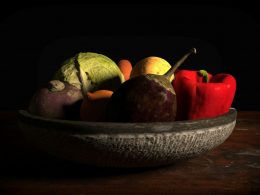Introducing Ioulia Chante – a Greek architect and craftswoman located in the Maltese islands.
Ioulia began to discover pottery and sculpture as a hobby in 2019 until she discovered the endless possibilities of what it meant to create by working with her hands! Her work explores forms, materials, and textures while being heavily inspired by flora and fauna, and expressing personal feelings and thoughts. Her quirky little works of art – from monster candle holders to contemporary wall art – bring inspiration and joy, much like herself!
Tell us about your creative background and how you started your creative journey!
Since I can remember, I’ve always enjoyed crafting by hand. It was a big part of my upbringing, whether I was sewing with my aunt, drawing with my mom, or using scraps from my dad’s workshop. At one point, I became particularly interested in making jewelry with beads and threads and for a while, I was tempted to study jewellery making.
When it came time to choose my career path, architecture seemed like the perfect fit. It combined artistic expression with engineering principles, which fascinated me. And it was indeed. I loved being an architecture student. Throughout university, I learned a great deal about crafting and detailing. Our school focused a lot on manual processes like drawing, model-making with cartons, scenography, and restoration.
I always wanted to incorporate the medium of clay in my studies, but pottery wasn’t popular where I lived at the time. However, when I moved to Malta, I discovered Space for Clay, one of the few studios on the island teaching multiple techniques of pottery. And so I began attending open courses in wheel throwing in the evenings. Since then I still carry on and actually, now I am fully dedicated to it. Pottery has expanded my creativity and helped me develop new design ideas that I can apply in architecture as well.

What’s your best piece of advice for someone who is just starting on their creative journey?
My best advice for someone just starting on their creative journey is simply to “just do it.” Create things that bring you joy and fulfillment. Explore new sources of inspiration, embrace your wildest ideas, and experiment with different mediums and creative practices. Often, trying something new can unveil unexpected paths of creativity.
Don’t be afraid to make mistakes; they are invaluable lessons that can lead to remarkable results. And never feel compelled to create solely based on others’ expectations or remain within your comfort zone. True creativity flourishes when you push boundaries and challenge yourself beyond familiar territories.
What do you do or where do you go when you need a creative boost?
Travelling to different places invigorates me. Experiencing something beyond my daily surroundings broadens my perspective and sparks inspiration. When I feel creatively stuck, I always seek nature, whether this involves going for walks or engaging in outdoor activities. There’s a profound wisdom and inspiration in nature. Observing patterns and details that nature organically creates, calms my mind, brings clarity, and fills me with euphoria.
I enjoy taking daily long walks through various neighborhoods in Malta. Exploring new places allows me to appreciate the craftsmanship and engineering that define traditional Maltese architecture, and search for similarities with my own culture to create something that can blend the two neighboring cultural identities.
Can you walk us through your design process?
It’s a somewhat chaotic process for me. I tend to doodle a lot of random things daily, though these sketches rarely evolve into actual pieces. Doodling serves as a spontaneous outlet for my ideas, allowing me to play with shapes, patterns, and even character sketches in an abstract manner.
Next, I experiment with shapes on the pottery wheel to create basic functional forms, attempting to incorporate some of my doodles onto the piece, or I develop an entirely new concept based on that initial form. At times, I start sculpting something that has just crossed my mind directly onto the piece, adding or subtracting details until I’m satisfied with the result.
Recently, I’ve been fixated on making little figurines instead of sketching. It’s akin to creating a draft model on a smaller scale that could potentially be scaled up into a larger piece. I find that my hands operate better in three-dimensional expression rather than in two-dimensional sketching.

What are the principles that shape your practice?
The principles that shape my practice include attention to proportions and details, as well as functionality. I conduct numerous case studies and research on anatomy, often focusing on body parts of animals or humans, as well as shells and natural structures. I strive to incorporate such details into the scale of the actual piece as accurately as possible but always in a personal way.
Creating functional objects is also a fundamental principle for me.
The art of pottery emphasises functionality and necessitates technical skills to produce items that are easy to use, proportionally correct, and aesthetically pleasing. I am particularly intrigued by the concept of integrating pieces of art into everyday life. Reflecting on the evolution of ceramic art, one can observe that many cultures throughout the years demonstrated exceptional creativity in crafting functional items that also served as works of art.
What are some challenges to your creative process? And how do you overcome these?
Time, space and equipment. Pottery is a very time-consuming craft that involves many different stages along the process and a lot of equipment to minimize the time of production. The lack of space or proper equipment demands the outsourcing of certain stages, such as firing, which is also time-consuming and very risky. The pieces are quite fragile at their drying stage before the first firing and you have to make sure that they will make it to the kiln intact, or else you will probably have to spend more time fixing or recreating them.
Being inventive and original is also another challenging part, that demands a lot of experimentation and study that may take years of research. I haven’t overcome some of these difficulties yet, but I have managed to organize myself in a way that I can work around them and I am currently trying to expand little by little.
Where do you work? What do you like most about your workspace?
I am working from home, sharing a dedicated workspace with my partner. I have my little dedicated corner. While it’s not overly elaborate and can feel a bit cramped at times, over the years, I’ve managed to optimize its functionality, and it serves me well. I have my pottery wheel and most of the essential tools needed for pottery.
For firing and glazing, I typically head to Space for Clay, the studio where my creative journey first began. This is where the final magic of the process unfolds. What I appreciate most about the studio is the cool equipment and machines that Rosella has but also the sense of community among the people there and their approach to this craft.

I am also attempting to maintain a 9-5 schedule, adhering to my previous workflow routine as it aids in sustaining my work-life balance. However, I don’t always adhere strictly to it. There are numerous instances where I find myself working on weekends or late into the night, particularly during periods of intense inspiration or when facing looming deadlines.
Additionally, there are times when pieces must be completed due to the material drying too quickly, necessitating immediate attention while the material retains some level of plasticity.
What are you working on right now? Do you have any exciting things in progress that you’d like to share?
At the moment, I am creating new batches of tableware and monsters, while also focusing more on experimenting with colors and textures. I have a lot of materials sitting in my workspace, and I’m eager to explore new combinations. This stage usually takes a lot of time, but it’s an exciting part of the creative process.
There are a few exciting things coming up! I will be hosting a short open studio day at Ta’ Xbiex Local Council on April 5 as part of the European Artistic Crafts Days, organized by the Malta Crafts Foundation, during this first week of April.
Additionally, our upcoming workshop with Ally Vella will take place on April 19 at Spazju ISSA in Ħamrun. I will also be leading a children’s collage workshop as part of the Small Bones of Courage exhibition on April 23 at Spazju Kreattiv.
I’m really looking forward to these events—it’s always fulfilling to share knowledge with the community.

Who are some local artists or creative heroes whose work you admire? Why?
There are numerous talents within the local scene, each with diverse practices and backgrounds, making it challenging to select just one. However, I find myself truly captivated by the ceramics of Paul Scerri and the paintings of Anna Calleja. Both artists pay great attention to detail and possess a highly personal mode of expression that evokes a sense of nostalgia.
Another creator whom I deeply admire is Cheryl Lofreda for her innovative approach to choreography and performing arts. Lastly, my creative hero throughout this journey has been my teacher, Rosella. She is among the few ceramists who generously shared her space and knowledge, nurturing an emerging community of ceramists to pursue their passions, including myself. Without Space for Clay, I likely wouldn’t have found myself creating monsters today.
il-lokal features are curated and written by il-lokal, a shop featuring work by over 80 local designers, artists, makers and independent brands from Malta. Visit il-lokal in Valletta, Mdina, and online www.il-lokal.com










